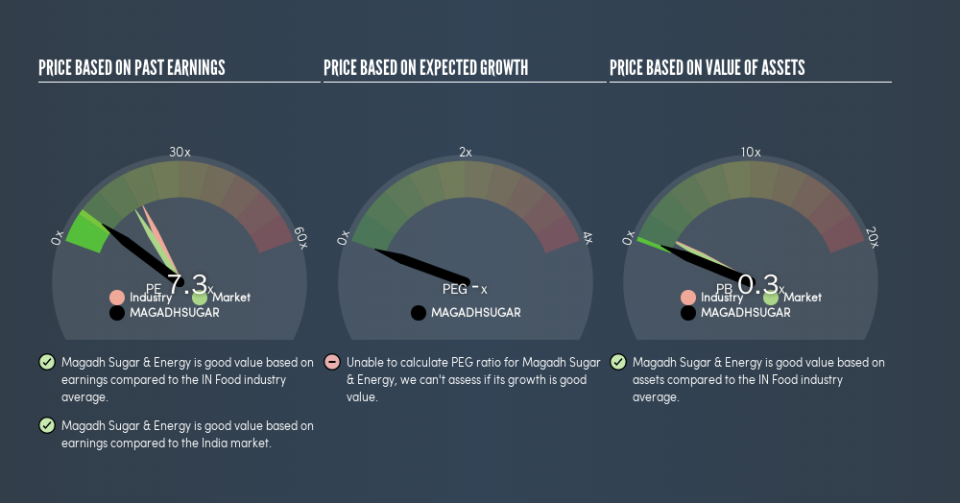Is Magadh Sugar & Energy Limited’s (NSE:MAGADHSUGAR) P/E Ratio Really That Good?

This article is for investors who would like to improve their understanding of price to earnings ratios (P/E ratios). We’ll show how you can use Magadh Sugar & Energy Limited’s (NSE:MAGADHSUGAR) P/E ratio to inform your assessment of the investment opportunity. Magadh Sugar & Energy has a price to earnings ratio of 7.29, based on the last twelve months. In other words, at today’s prices, investors are paying ₹7.29 for every ₹1 in prior year profit.
See our latest analysis for Magadh Sugar & Energy
How Do You Calculate A P/E Ratio?
The formula for P/E is:
Price to Earnings Ratio = Price per Share ÷ Earnings per Share (EPS)
Or for Magadh Sugar & Energy:
P/E of 7.29 = ₹125.65 ÷ ₹17.23 (Based on the trailing twelve months to December 2018.)
Is A High P/E Ratio Good?
A higher P/E ratio implies that investors pay a higher price for the earning power of the business. That isn’t necessarily good or bad, but a high P/E implies relatively high expectations of what a company can achieve in the future.
How Growth Rates Impact P/E Ratios
P/E ratios primarily reflect market expectations around earnings growth rates. Earnings growth means that in the future the ‘E’ will be higher. Therefore, even if you pay a high multiple of earnings now, that multiple will become lower in the future. So while a stock may look expensive based on past earnings, it could be cheap based on future earnings.
Magadh Sugar & Energy shrunk earnings per share by 48% over the last year. But over the longer term (3 years), earnings per share have increased by 9.2%.
How Does Magadh Sugar & Energy’s P/E Ratio Compare To Its Peers?
The P/E ratio indicates whether the market has higher or lower expectations of a company. We can see in the image below that the average P/E (19) for companies in the food industry is higher than Magadh Sugar & Energy’s P/E.
This suggests that market participants think Magadh Sugar & Energy will underperform other companies in its industry. Many investors like to buy stocks when the market is pessimistic about their prospects. You should delve deeper. I like to check if company insiders have been buying or selling.
Don’t Forget: The P/E Does Not Account For Debt or Bank Deposits
It’s important to note that the P/E ratio considers the market capitalization, not the enterprise value. Thus, the metric does not reflect cash or debt held by the company. In theory, a company can lower its future P/E ratio by using cash or debt to invest in growth.
Such expenditure might be good or bad, in the long term, but the point here is that the balance sheet is not reflected by this ratio.
Is Debt Impacting Magadh Sugar & Energy’s P/E?
Magadh Sugar & Energy’s net debt is considerable, at 282% of its market cap. This is a relatively high level of debt, so the stock probably deserves a relatively low P/E ratio. Keep that in mind when comparing it to other companies.
The Verdict On Magadh Sugar & Energy’s P/E Ratio
Magadh Sugar & Energy trades on a P/E ratio of 7.3, which is below the IN market average of 16.6. When you consider that the company has significant debt, and didn’t grow EPS last year, it isn’t surprising that the market has muted expectations.
Investors have an opportunity when market expectations about a stock are wrong. If it is underestimating a company, investors can make money by buying and holding the shares until the market corrects itself. We don’t have analyst forecasts, but you might want to assess this data-rich visualization of earnings, revenue and cash flow.
But note: Magadh Sugar & Energy may not be the best stock to buy. So take a peek at this free list of interesting companies with strong recent earnings growth (and a P/E ratio below 20).
We aim to bring you long-term focused research analysis driven by fundamental data. Note that our analysis may not factor in the latest price-sensitive company announcements or qualitative material.
If you spot an error that warrants correction, please contact the editor at editorial-team@simplywallst.com. This article by Simply Wall St is general in nature. It does not constitute a recommendation to buy or sell any stock, and does not take account of your objectives, or your financial situation. Simply Wall St has no position in the stocks mentioned. Thank you for reading.


